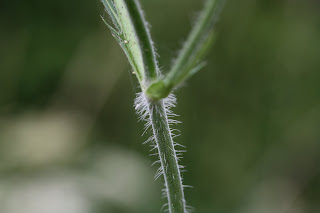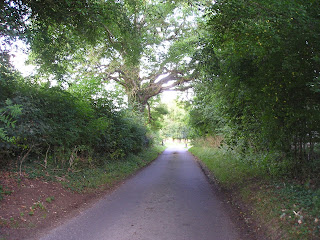Scabious: Wild and Tame
Regular readers of this blog will know that I am very fond of garden plants that have not been messed around with too much. By that, I mean I generally prefer the simpler flowers. So-called 'improvement' is so often just another word for vulgar, blousy and big - although there are occasions when I have a need for both the blousy and vulgar!
Scabious are a delight regardless, whether they are growing in the hedgerow or the border.
.

The secret valley is awash with scabious, as well as other wild flowers, at the moment. The dry weather seems to suit them for they are looking just perfect. They seem to be everywhere - they especially like roadside verges but also grow in odd pockets of wasteland on very poor soil. But it is not just the secret valley where they are found, for the whole of the Cotswolds seems to be a haze of powder blue. In fact, they grow pretty well throughout the British Isles although they are much more scarce in Scotland.
.

I have found photography and blogging has improved my powers of observation for it is only recently that I noticed that the scabious has quite hairy stems. These feel quite soft to the touch, so it was with some surprise that I learnt that they are closely related to teasels, whose hairs have been modified into sharp, protective spines.
.

However, it was only when looking at these pictures that I noticed how the flowers open from the outer edge and then work there way inwards. Obviously, my powers of observation have still some way to go!
.

As garden plants, in my opinion, they are superb. Always tidy, never need staking and, with regular dead heading, flower continuously from mid June onwards. In the photos below, scabious is being grown in a cottage garden border (this is Scabiosa caucasica but still pretty!) amongst pale pink Icelandic poppies. The scabious is perennial and will grow again every year, the poppies are annuals. I just threw some poppy seed down amongst them and, as the poppies were mixed colours, removed any that turned out not to be pink. Simple!
.
As an ingredient for containers they are unrivalled, too. Here, in huge one metre square pots, they form an underplanting with Salvia nemerosa and small flowered petunias beneath the (very) light shade of Cornus controversa 'Variegata'. This scabious is an improved form of our wild flower - it is dwarfer than the type.
.
 .
.
The Five Spot Burnet moth flies in daylight and is everywhere at the moment. They especially seem to like feeding on the scabious, choosing these above the profusion of other wild flowers. They are very pretty and when the light catches them at the right angle, the black ground of their wings become irradescent, similar to the 'black' feathers of the magpie and farmyard cockeral.
.
 .
.
 Going.....
Going.....
.
Going.......
.

Gone!
.
Like many plants, occasionally a 'sport' arises. Driving home today, I noticed just two white flowered scabious growing by the side of a country lane. Beautiful!



As an ingredient for containers they are unrivalled, too. Here, in huge one metre square pots, they form an underplanting with Salvia nemerosa and small flowered petunias beneath the (very) light shade of Cornus controversa 'Variegata'. This scabious is an improved form of our wild flower - it is dwarfer than the type.
.
 .
.The Five Spot Burnet moth flies in daylight and is everywhere at the moment. They especially seem to like feeding on the scabious, choosing these above the profusion of other wild flowers. They are very pretty and when the light catches them at the right angle, the black ground of their wings become irradescent, similar to the 'black' feathers of the magpie and farmyard cockeral.
.
 .
. Going.....
Going......

Going.......
.

Gone!
.
Like many plants, occasionally a 'sport' arises. Driving home today, I noticed just two white flowered scabious growing by the side of a country lane. Beautiful!


I love purples, and pink and whites in a garden. Lovely flowers there, cool moth too ! thanks, Gina
ReplyDeleteAh yes I remember those growing everywhere when I lived there. I think I should get some for the perennial beds, I love the pastels.
ReplyDeleteThanks,
Doc
Thanks both. Do grow some, they are straightforward plants and good as cut flowers too indoors.
ReplyDeleteJohnson
Beautiful pics!
ReplyDelete